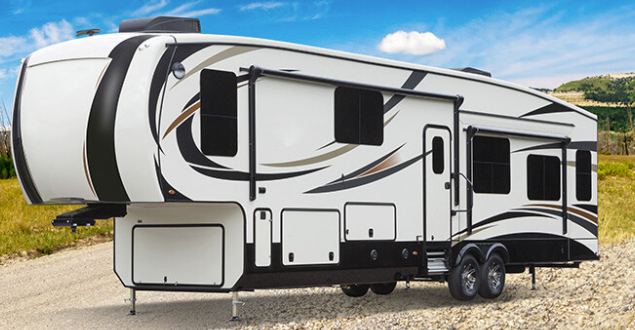Towing a Fifth Wheel: What Every RV Owner Needs to Know

Unlike a traditional travel trailer, a fifth wheel RV connects to a special hitch inside of the truck bed, which helps with weight distribution and stability. However, towing a fifth wheel still requires the right tow vehicle, proper hitch setup and careful driving techniques. This guide covers everything you need to know, from choosing the right truck to navigating turns and backing up.
What Makes Towing a Fifth Wheel Different?
If you’ve towed a travel trailer before, you’ll notice a few key differences when moving to a fifth wheel:
- Fifth wheels connect in the truck bed – Unlike a bumper-pull travel trailer, the hitch sits over the rear axle, creating a more balanced tow.
- Better weight distribution – Since the tongue weight is centered in the truck bed, there’s less swaying compared to bumper-pull trailers.
- Requires a pickup truck – You need a properly equipped tow vehicle with a fifth-wheel hitch, so SUVs and small trucks aren’t an option.
Choosing the Right Tow Vehicle for a Fifth Wheel
A fifth wheel is only as stable as the truck pulling it. Choosing the right tow vehicle means understanding weight ratings, engine power and hitching requirements.
Understanding Weight Ratings
Your truck needs to be able to safely handle the total weight of the fifth wheel, passengers and cargo. Here are the key numbers to check:
- Gross Vehicle Weight Rating (GVWR): The maximum weight your wheel RV can be when fully loaded
- Towing capacity: How much weight your truck is rated to tow safely
- Payload capacity: The maximum weight the truck bed can handle,including the hitch, passengers and gear
Using a weight chart can help you match your truck’s weight rating with your fifth wheel’s actual load.
Diesel vs. Gas Trucks for Towing
- Diesel trucks – Higher torque makes them ideal for pulling heavier loads, especially in mountainous terrain.
- Gas trucks – Can tow smaller wheel RV models but may struggle with heavy loads or long-distance towing
If you're considering an RV for a large family, you may need a more powerful tow vehicle to handle the extra weight. Check out our guide on the best RVs for large families to find spacious models that fit your needs.
How to Hitch a Fifth Wheel for Safe Towing
A fifth wheel hitch is different from a standard ball hitch and mounts inside of the truck bed. Here’s how to hitch up correctly:
Step-by-Step Hitching Process
- Line up the truck and trailer – Back up slowly, aligning the kingpin with the hitch in the truck bed.
- Lower the tailgate and secure the hitch jaws – Engage the locking mechanism and double-check for a tight fit.
- Check tongue weight – Make sure the tongue weight (or pin weight) is 15–25% of the total trailer weight for stability.
- Test the connection – Move forward slightly to ensure the hitch is secure before hitting the road.
For short-bed trucks, a sliding hitch may be needed to prevent the front of the fifth wheel from hitting the cab during sharp turns.
Safe Towing Practices for Fifth Wheels
Once you’re hitched up, following safe towing practices is key to a smooth ride.
Weight Distribution & Tongue Weight
- Unlike a travel trailer, a fifth wheel distributes weight directly over the rear axle, reducing sway.
- Always ensure your weight rating stays within safe limits.
- Check your tongue weight before every trip—too little weight can cause instability, while too much can strain your tow vehicle.
Braking & Turning with a Fifth Wheel
- Use a brake controller – Fifth wheels have their own electric brakes, which need to be synchronized with your truck’s braking system.
- Make wider turns – The pivot point is in the truck bed, so turning too tightly can cause clearance issues.
- Allow extra stopping distance – A loaded wheel RV is heavy, so braking takes longer.
Handling Wind & Steep Roads
- Slow down in high winds – Even though fifth wheels have less sway than travel trailers, strong crosswinds can still affect stability.
- Use engine braking downhill – Downshifting reduces wear on your brakes when going down steep grades.
Backing Up a Fifth Wheel
Backing up a fifth wheel is different from backing up a travel trailer. The turning response is slower, and it requires careful steering.
Tips for Easier Backing
- Turn the steering wheel in the opposite direction you want the trailer to go.
- Make small adjustments—overcorrecting can cause the trailer to jackknife.
- Use a spotter or backup camera when maneuvering in tight spaces.
Practice in an open area before attempting to park in a crowded campground.
Final Tips for Fifth Wheel Owners
- Perform a pre-trip checklist, including checking tire pressure, brakes and hitch security.
- Stay within your truck’s weight rating to avoid safety risks.
- Regularly maintain both your truck and your wheel RV to prevent unexpected breakdowns.
If you’re still deciding on an RV that fits your travel style, check out our guide on the best Class C RVs for 2025 for top models with great towing flexibility.
Find the Right Fifth Wheel for Your Truck
Towing a fifth wheel requires the right setup, careful driving and a tow vehicle that can handle the load. Whether you’re upgrading your RV or buying your first wheel RV, choosing the right model is essential.
Use our RV Selector Tool to compare fifth wheels based on your truck’s weight rating, towing capacity and lifestyle needs. With the right setup, you’ll be ready for smooth, safe towing on your next adventure.